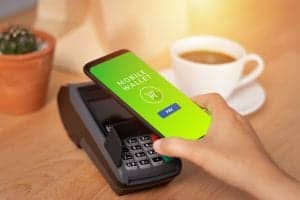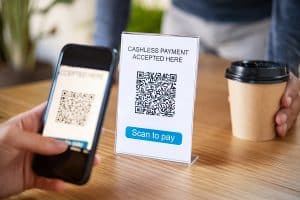Our guide on NFC payments explains what they are, how they work, how safe they are, and why your business should accept them.
Our content reflects the editorial opinions of our experts. While our site makes money through
referral partnerships, we only partner with companies that meet our standards for quality, as outlined in our independent
rating and scoring system.
What is an NFC payment? There’s a good chance you’ve heard the term even if you haven’t used the technology yourself.
The appeal of NFC’s convenience factor among consumers is easy to understand. Payments processed using NFC-enabled mobile devices appear to be on course to account for more than $130B in consumer retail purchases worldwide.
Near-field communication (NFC) technology has ushered in an era of secure and convenient payment transactions for both consumers and businesses of all sizes.
Read on to discover everything you need to know about NFC payments and why alternative payment options, including NFC, represent the future of contactless payment processing.
What Is An NFC Payment?
An NFC payment is a financial transaction made between two devices within very close proximity. For example, using your iPhone at point of sale by holding it near a credit card terminal. Many credit and debit cards are now also equipped with EMV chips that can be tapped against a terminal to make a transaction, and most of the best POS systems will accept these payments.
NFC stands for near-field communication, a technology that lets customers and merchants process payments between two devices that are in close physical proximity to one another. NFC uses wireless, contactless communication protocols called radio-frequency identification, or RFID, to identify transponder tags attached to other objects, such as card readers and terminals. RFID technology uses a reader with an onboard power source and antenna to talk with and transfer data to a transponder tag.
NFC allows contactless cards like those in your smartphone to make secure transactions and exchange content when they’re near each other or a terminal with NFC capabilities.
How To Accept NFC & Contactless Payments
So how do you use NFC technology? NFC devices, which are based on RFID protocols, can work as powered readers and transponder tags within short-read range parameters. NFC technology deploys in three different forms: tag reader and writer, device-to-device, and card emulation:
- Tag Reader & Writer NFC: With the tag reader and writer form of NFC, smartphones can read “tags” (small stickers with embedded NFC chips), similar to the concept of the QR code reader that can scan barcodes attached to objects.
- Device-To-Device NFC: Device-to-device NFC allows you to exchange multimedia and digital content, such as photos, videos, and contact information, between two NFC-enabled devices. Samsung, for example, has been using NFC in its phones for nearly a decade. Android has also been using NFC as a standard on all its devices for easier content sharing.
- Card Emulation NFC: Card emulation is a promising area in NFC and a driving force behind modern mobile payments. Digital wallet services (such as Apple Pay and Samsung Pay) use card emulation to secure card data during a transaction without storing or handling payment card numbers on the NFC chip itself.
Merchants, generally, will need to invest in a card terminal or reader that has NFC capacity. The good news is NFC capabilities are becoming a more and more standard feature in card readers and terminals.
Does It Cost More To Accept An NFC Payment?
You may be wondering how much this will cost you. You’ll be happy to hear that accepting NFC transactions doesn’t cost any more than accepting a standard dipped credit card transaction. The cost is entirely in the hardware, so it’s a one-time expenditure. If you’re due to update your POS systems, it’s probably worth upgrading to NFC-capable hardware.
How Does An NFC Reader Work?
Smart devices and NFC-capable EMV credit/debit cards can communicate with an NFC-enabled POS system to complete a transaction:
- A mobile device or NFC-embedded card and point of sale system must be within about two inches of each other to initiate the payment processing
- The smart device is held close to the terminal by the customer, which processes payments and begins exchanging data
- Using a specific RFID frequency for a close-range transference of data, the customer’s smart device and payment terminal exchange encrypted data in a matter of seconds to complete the transaction
What Are NFC Mobile Payments?
In general, merchants and customers can expect to see two different types of commonly used NFC mobile payments: pay app-enabled payments and “tap-to-pay” payments. Check out the following list for more details on each payment type:
- Pay Apps: Most content online or on the web relies on pay apps to process NFC mobile payments. These mobile pay apps (Apple Pay, Samsung Pay, and Google Pay are all popular NFC payment apps) work simply by hovering a device over a card reader that processes payments from customers’ digital wallets. Devices that you can use to pay include phones, smartwatches, or credit cards with embedded chips. Pay apps have grown significantly in importance since the outbreak of the COVID pandemic; it’s become essential for merchants to have a payment processing solution for their customers that doesn’t require physical interaction and isn’t error-prone.
- Tap-To-Pay: Newer “tap-to-pay” NFC mobile payments use credit cards embedded with special NFC chips. These chips allow customers to tap their credit cards against card readers to process low-value purchases, such as those at convenience stores. This type of NFC mobile payment focuses on convenience for quick, inexpensive purchases and is most commonly seen in Europe and Canada (although it’s steadily gaining ground in the US as well).
Is An NFC Payment Safe?
While the technology isn’t foolproof, it’s about as safe as dipping an EMV-chipped credit card into a POS terminal, which is currently the gold standard for credit card transaction security. They’re considered on par with dipped EMV chips in terms of security. Merchants will be happy to know NFC payments are treated like EMV transactions for purposes of liability and EMV compliance. This means, as a business, you’d rather see a customer make an EMV transaction than swipe their credit card through a magnetic stripe reader.
Using a process called tokenization, card numbers are, in fact, never stored in an app or anywhere on an operating system. Instead, they are replaced with a “token” — essentially a secret, one-time-use number — after the credit or debit card has been added to a mobile wallet. Hackers can’t easily access useful information from terminals even if they manage to hack them, especially if all your transactions use NFC or EMV payments. On top of that, smart devices get a second layer of encryption through forms of two-factor authentication, such as passcodes, face ID, and push notifications.
Should Your Business Accept NFC Payments?
There’s essentially no risk (other than the initial investment) to accepting NFC payments and quite a bit to gain.
Let’s sum up some of the benefits of NFC payments:
Pros
- Security: NFC payments are more secure than magstripe readers and roughly equivalent to those of dipped EMV chips.
- Reduced Liability: As of October 2015, using a magstripe reader for POS payments puts your business in a disadvantageous legal position when resolving fraudulent charges.
- Sanitation: Terminal keypads and touch screens make contact with a lot of fingers over the course of the day. NFC allows for contactless payments.
- Reach More Customers: In combination with cash and credit cards, more payment methods translate into more sales, all else being equal. You can sell to a customer who remembered their phone but not their wallet, for example.
- Future-Proofing: NFC isn’t going away any time soon and, with EMV chips now more commonly equipped with NFC, is set to make up an ever-growing percentage of transactions.
- Speed: NFC transactions can be faster and keep your lines moving more quickly than dipped cards and even swiped cards.
- Reduced Wear-And-Tear: Physical contact with your terminal adds up over time. Contactless payments put less structural stress on your hardware.
- Centralizing Loyalty Programs: Mobile devices hold more than just digital and mobile wallets; they can also be home to loyalty apps and digital coupons for your store. NFC payments can make your customer more likely to engage with your programs.
NFC Payments Are The Future: Are You Ready?
The number of major retailers that are adding NFC capabilities continues to grow every day, with the trend having accelerated during the COVID-19 pandemic due to increased interest in contactless payments.
If you’re wondering if you need NFC, the answer is: if you don’t already, you will soon enough. You can probably get by on your current EMV-compatible readers until it’s time for your next upgrade, but at that point, you’ll strongly want to consider adding NFC capabilities to your POS systems.
Do you want to learn more about mobile wallet payments and credit card readers? Visit our complete guide to mobile credit card readers for a deeper dive into payment card readers, terminals, and POS systems, as well as all of the associated functionalities that are most important to your business’s continued growth and success.
Common Questions About NFC Technology & NFC Payments
Can NFC be hacked?
Sort of. Technically, hackers can use NFC to exploit security flaws in hardware. That’s why encryption and tokenization are essential; it keeps sensitive information out of vulnerable devices. Ironically, it’s magstripe credit card data that is most vulnerable to being stolen this way.
Can NFC be used to spy?
In theory, yes, NFC can be used to spy. However, in real-world scenarios, a lot has to go wrong first. NFC is distance limited, so the victim or victimized device needs to get within a few centimeters of the malicious device. Both devices would need to have NFC enabled at that moment. The hacker would then need to exploit a security flaw and/or user negligence to get malware onto the device.
How safe are NFC payments?
NFC payments are considered to be about on par with EMV payments as far as security goes. They’re considered more secure than magstripe swipes.
What data does NFC transfer?
NFC payments transfer a token, a one-time use transaction code that corresponds to your credit card information. As the token’s lifespan is very short and corresponds to a specific transaction, it’s difficult to utilize for fraud.
What can NFC be used for?
NFC can be used for a number of purposes, including:
- Payments
- Data sharing
- Connecting devices
- Triggering “events” in an NFC-enabled device (starting a car, for example)
- Opening a link (similar to QR code)
How do I get NFC on my phone?
If you have a modern smartphone, then it should already be equipped with NFC technology right out of the box. To use it to make transactions, you’ll want to set up your device’s wallet.
How can I use NFC to pay?
To use NFC to pay, you’ll need to set up your mobile wallet (such as Apple Pay or Google Pay). When you wish to make a transaction, you’ll hold your device in proximity to an NFC-capable terminal or mobile card reader.











